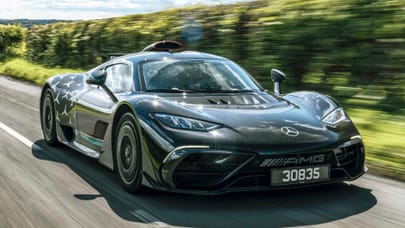
Classified ad of the week: McLaren F1
When we saw the new McLaren MP4-12C Spider, we became somewhat feverish. "It could be the very best of the bunch" we opined while wiping away bubbling saliva from our chin. But the McVert is son to a legend: the physics-bending, statistical smackdown that is the F1. And now you can own one. All you need is an astronomical amount of money. And a cargo ship anchored off Hong Kong.
But first, some history. If you didn't already know, the McLaren F1 was conceived by F1 designer Gordon Murray, who convinced McLaren Chairman, Ron Dennis, to build the fastest road car in the world. Which, he did, creating not just a supercar par excellence, but a 242.95mph (with the rev limiter removed) record breaker that remains among the fastest moving things on the planet. Just look what happened when Richard Hammond raced one with a Veyron.
It was, as you'd imagine, pretty expensive when it launched in 1993. £500,000, to be precise. But you got your money's worth - the engine bay was lined with 16 grams of gold for heat reflection, it came with a completely new and unique six-speed gearbox because there wasn't anything in the world that could cope with the BMW V12's power, it got from 0-60 in 3.2 seconds, and it was the first ever carbon fibre-bodied car.
Though there wasn't much in the way of electronic fripperies - no ABS, no traction control, no nothing. All you got to help manage the 618hp (550hp per ton, which is 19.8hp more than a Veyron) were four unassisted four-pot aluminium brakes and some tyres developed solely for the F1 by Goodyear and Michelin.
You do get a jolly good view, though - the driver's seat's set in the middle ahead of the fuel tank and engine, with passenger seats slightly behind and on each side of the centre. From here you got experience the wide-eyed moments before you smeared yourself up a tree/wore Planet Earth as a hat/resculpted some Armco in glorious panoramic vision.
But lots of Very Clever People put in a lot of work to keep tree smearing/upside downyness to a minimum. From its inception, McLaren decided this was going to be a road car that could be piloted by the uninitiated. The F1's mass was centred to 42 per cent front and 58 per cent rear to stave off unsavoury weight transfer effects, and unfathomably impenetrable algorithms were used to design the super-stable double wishbone suspension's camber and castor angles.
Then there's the good bit - the engine. Gordon Murray insisted it was normally aspirated for reliability reasons, so he knocked on Honda's door (they were in partnership at the time with the dominating Honda/McLaren F1 cars) for an engine with 550bhp, 600mm block length and overall weigh of 250kg. The Japanese firm politely declined. In the end, BMW's M division stepped in and built him a 6.1-litre V12 with 618hp that weighed 266kg, 14 per cent more powerful and 16kg heavier than Murray's original spec. Because it was bigger, it needed more heat insulation, hence the gold engine bay.
We can only presume that all the good enginey, goldy stuff is still present in this 1997 model, because the vendor's only supplied one picture. They've also failed to provide a pricetag, but with market values hovering around the £5m mark, if you've got to ask you probably can't afford it...
We do know that it has 6400 miles on the clock, it's still got the original toolkit, McLaren luggage, McLaren watch and it has a full McLaren service history that was last stamped at the factory in 2011.
Top Gear
Newsletter
Thank you for subscribing to our newsletter. Look out for your regular round-up of news, reviews and offers in your inbox.
Get all the latest news, reviews and exclusives, direct to your inbox.
Now tell us, if this landed on your driveway, where would be the first place you'd drive to? Moncao? St Tropez? Cash4Gold?
Trending this week
- Car Review
BMW 1 Series
- Top Gear's Top 9
Nine dreadful bits of 'homeware' made by carmakers








